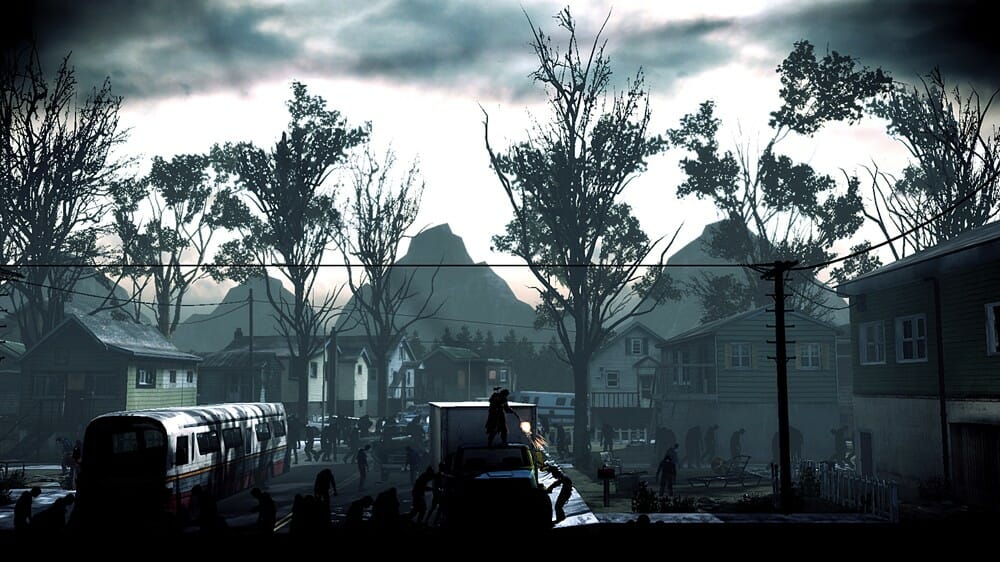Deadlight (XBLA)

Deadlight is a game by a Madrid-based studio in which a Canadian man, Randall Wayne, makes his way through a zombie-infested Seattle in the summer of 1986. He’s looking for his wife and daughter. It’s a 2D platformer, similar to the original Prince of Persia. This is purely Randall’s journey—you’ll guide him from point to point, but Randall makes the important choices. And it’s not a long journey—my final playtime was under two hours, although the game only counted the times I was successful in completing levels.
1986 informs the audio and the visuals more than the play. Randall regularly spouts anti-communist rhetoric. The saving/loading icon is designed to look like the spinning reels of an audio cassette, and the game tells you not to “turn off or devour the console” when it’s displayed. You find Tiger Electronics-style handheld in each of the game’s three acts and play them to beat the high score.
There are other collectibles—ID cards on corpses, flyers and documents revealing bits of information about the game world. Most are located right on the main path. Objects you can interact with or climb on are highlighted with a faint outline as you approach them. An icon will appear onscreen if you are near something you can pick up.
It fits with Randall’s obsessive single-mindedness, moving solely along one plane. The zombies are also single-minded, easily taunted to their deaths. The game is single-minded, throwing the same situations at you over and over again (usually involving a zombie, an environmental hazard and the taunt button).
And while they’re both silhouettes (in Deadlight’s 1986 they’re called “Shadows”, because of the metaphor), the zombies are in a way freer than Randall. They can move into his plane from the foreground or background, whichbecomes a pain when you’re not sure if they’re in a position to be hit with an axe or shot with a gun yet.
The zombies also don’t keep obsessive diaries. Viewed from the pause menu or the loading screen, much of Randall’s diary is complete when the game starts. The earliest entry is from 1985, and the final entry summarizes the game’s opening cutscene. Randall finds more pages of his own diary along his journey, which is weird—why would pages of this man’s personal diary be scattered somewhere in a city he’s never been to?
To make sense of it, you have to step out of the literal mode that a game usually requires you to think in, one where everything is as it seems (or, if it’s not, is exactly what it is ultimately revealed to be). Think of the diary’s missing pages as blanks in Randall’s memory.
That’s what unifies Deadlight’s play and its visuals and its audio: it doesn’t quite hang together. By the end of the game, I still couldn’t quite judge whether or not Randall could make a jump (usually he could, because he had to: there was only one direction to go). I don’t know if it had something to do with the ratio of distance to his body length or what. Many times it would look like he was about to miss a ledge when he would grab it.
In addition to Randall’s apparently magic ability to grab ledges just beyond his grasp, he can also kick off of walls to jump higher. This, though, is part of the game itself. The man can’t swim, but he can sort-of parkour (the few times you’ll be wading through chest-deep water have a sluggish animation that really conveys Randall’s difficulty moving here).

The language is bombastic, and yet feels slightly wrong—when Randall writes in his diary that he has a “big family” (which consists of himself, his wife, and his daughter), is it a mistranslation (grande into “big” instead of “grand”, maybe?), or an insight into his character (how isolated and detached is a man who can describe a family of three as “big”?). When he mutters to himself, he controts a cliché like “history is written by the winners” into “the stories of the battle are written by those who survive the war”. That inarticulateness might contain extra meaning, or it might just be awkward writing.
-

-

-

-

-

-

-

-

-

-

-

-

-

-

-

-

-

-

-

-

-

-

-

-

-

-

-

-

-

-

-

-

-

-

-

-

-

-

-

-








































